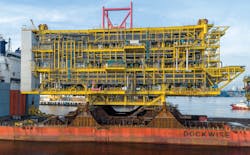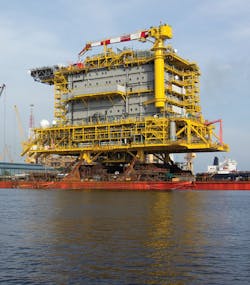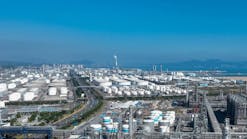Culzean gas field nears production
Total SA expects the high-pressure, high-temperature (HPHT) Culzean natural gas and condensate field to come on stream in 2019. Peak production is expected by 2020-21.
Culzean field is on the East Central Graben of UK North Sea Block 22/25a (License P111) about 145 miles east of Aberdeen in 88 m of water. Total SA took operatorship of Culzean through its Maersk Oil acquisition, effective Mar. 8.
Total Chief Executive Patrick Pouyanne said Total’s acquisition of Maersk Oil stemmed in part from Total’s belief that world gas markets will grow faster than crude oil markets for the next 20 years because of growing Asian gas demand.
Jean-Luc Guiziou, Total E&P UK managing director, said of Culzean in late May, “We still have much to achieve between now and first gas in 2019, but the work carried out to date has set us up well for the remainder of this significant project.”
Topsides for harsh-environment operations in Total-operated Culzean field were constructed in Singapore and recently moved to the UK North Sea about 145 miles east of Aberdeen. The wellhead topsides were designed for a 12-slot platform (Fig. 1). Photo from Sembcorp Marine.
Total holds 49.99% interest in Culzean field. Partners are BP (Britoil) with 32% and JX Nippon Exploration & Production (UK) Ltd. with 18.01%. The field, discovered in December 2008, contains gas and condensate within Triassic and Jurassic reservoirs.
The UK Oil & Gas Authority in 2015 approved plans for the $4.5 billion development, which Maersk at the time said benefitted from an HPHT cluster area allowance, an incentive by the UK government supporting HPHT projects, which tend to have high capital costs.
Culzean development features three platforms: a 12-slot wellhead platform (WHP), a central processing facility (CPF), and utilities and living quarters (ULQ) for 100 people. Two bridges, about 100 m long, will link the platforms.
Maersk Oil spudded the first production well in late September 2016 using the Maersk Drilling Highlander jack up rig. More than 30 well-services companies support a planned continuous 5-year drilling program for Culzean field, which is expected to produce 60,000-90,000 boe/d for at least 13 years at its plateau. The Culzean sandstone reservoir, discovered in 2008, is about 4,300 m below sea level, with 13,500 psi and 175° C.
The central processing facility is shown ready for its trip from Singapore to Culzean field in the UK North Sea. The field is scheduled to come on stream in 2019 (Fig. 2). Photo from Sembcorp Marine.
Drilling logistics
Maersk Drilling and Maersk Oil jointly prepared for drilling Culzean production wells using a specialized drilling simulator at Aberdeen’s Robert Gordon University that replicated the Maersk Highlander jack up drilling the wells.
Crews practiced with drills to address anticipated drilling problems. RGU specialists observed the training and provided advice on both human error and technical aspects of the project.
“Working on a virtual rig designed to look and feel like the Maersk Highlander has been invaluable,” Andrew Lough, Culzean’s well delivery manager, said in 2016. “It has enabled us to prepare in a very lifelike environment,” enhancing safe, efficient drilling.
The actual rig is a high-specification, harsh-environment, self-elevating jack up based on a Friede & Goldman JU-2000E design but outfitted with certain improvements.
The Maersk Highlander can operate in 400 ft of water and drill to 30,000 ft. It features a static hook loading capacity of 2 million lb and a cantilever reach of 75 ft. It has duplicate 15,000 psi blowout preventer systems, a 2-million lb drilling capacity, and 6,000 bbl of mud capacity. The jack up accommodates 150 people.
DNV GL verified the Ailsa FSO was designed for twice the average hull fatigue life of other newbuild FSOs. The Ailsa also was designed to operate 25 years in Culzean field without drydocking (Fig. 4). Photo from Sembcorp Marine.
Efficiency and drilling vertically were key for Culzean field. Crews drilled seven 36-in. tophole sections in a batch sequence with fewer than 4 days between wells, highlighting the need to quickly identify operational issues and equipment changes needed to improve performance in each subsequent well.1
The tophole angle was important because the WHP consists of 12 slots with 3.25 m center-to-center spacing. The six production wells for Phase 1 are planned for Slots 4, 5, 7, 8, 10, and 11. A produced water reinjection well occupies Slot 3.
Well design required wells to remain vertical through the 36-in. section and down to a kickoff depth of 2,500 ft in the 26-in. section. The verticality limit was less than 0.5° inside the 30-in. casing.
Crews drilled Well C1 without incident though the rate of penetration was lower than expected. But borehole inclination increased while drilling the next two wells. Reaming corrected the inclination but was suspected to have caused damage found on the 26-in. × 36-in. hole opener.
Engineers redesigned the bottomhole assembly (BHA) because reaming hindered operational efficiency. The fourth well included an additional 17.5-in. rotary steerable system (RSS) between the 17.5-in. bit and the 26-in. × 36-in. staged hole opener. Drillers used the RSS for the next three wells.
To avoid collisions, wells drilled from the middle platform slots had to stay within 3.5 ft of the original well center. Wells drilled from the external slots could tolerate greater variance.
Tophole drilling included about a 2% chance of encountering large rocks below the WHP. This was confirmed on Well C5 when workers recovered two such rocks from the hole opener.
The rock zone likely influenced an initial change in drilling direction, which was lower in wells drilled with the RSS. Well C1 met the allowable deviation from well center of 3.5 ft but Well C2’s deviation measured 3.71 ft and Well C3’s 3.66 ft. All four wells drilled using the RSS stayed within the 3.5 ft deviation criteria.
Culzean utilities-living quarters topsides were built in Singapore and moved to the North Sea along with two other Culzean modules that will be linked by bridges. The living quarters are separated from the HPHT production platform for safety (Fig. 3). Photo from Sembcorp Marine.
Jackets, topsides
Heerema Fabrication Group built three jackets to support the topsides. Three of six Phase 1 production wells are scheduled to be ready to go on stream when hooked up in 2019. Produced gas will be exported via the Central Area Transmission System (CATS) pipeline, coming onshore at Teesside in northeast England. Condensate will be exported via a short pipeline to a floating, storage, and offloading (FSO) vessel, the Ailsa, that can store 430,000 bbl of condensate.
Heerema Marine’s deepwater construction vessel Thialf completed installation of the CPF and ULQ jackets on July 20, 2017, having installed the WHP jacket in 2016. Engineers designed Culzean’s jackets for a lifespan of more than 40 years to ensure durability through anticipated field production.
Sembcorp Marine completed construction of the three fixed platform topsides in 32 months. The 30,000-tonne WHP topsides will handle up to 500 MMscfd of gas and 25,000 b/d of condensate.
The WHP (Fig. 1) and CPF (Fig. 2) left Singapore for Culzean field in early May. At press time, the ULQ topsides (Fig. 3) were expected to depart soon. Sembcorp Marine subsidiary Sembmarine SLP built the power-generation module and the two interconnecting bridges
Culzean utilities-living quarters topsides were built in Singapore and moved to the North Sea along with two other Culzean modules that will be linked by bridges. The living quarters are separated from the HPHT production platform for safety (Fig. 3). Photo from Sembcorp Marine.
In May, Sembcorp Marine announced completion of the Ailsa FSO. Sembcorp subsidiary LMG Marin AS designed the hull for the turret-moored FSO, which is 243.2 m long and 21.6 m deep with a 42-m beam.
Marine assurance company DNV GL verified that the Ailsa FSO (Fig. 4) features twice the average hull fatigue lifespan of other newbuild FSOs. Longer hull life enables a vessel to withstand more extreme conditions, such as waves, corrosion, temperature variation, and storms. Ailsa was designed to operate 25 years without drydocking.
Sateesh Dev, president and chief executive officer of Modec Offshore Production Systems (Singapore) Pte. Ltd., said Ailsa was Modec’s first North Sea vessel although it is Modec’s 46th floating unit for the oil and gas industry.
Modec supplied the internal turret and topsides modules, including a vapor recovery unit and metering skid, which Sembcorp Marine will install and integrate.
References
1. Hyland, K., Laing, M., Mathieson, G., O’Neill, D., Boyce, F., Keen, A., Tarn, A., and Milne, R., “HPHT Wells Spudded Utilizing a Rotary Steerable System Below a 26-in. × 36-in. Hole Opener to Improve Tophole Drilling Performance,” International Association of Drilling Contractors and the Society of Petroleum Engineers Drilling Conference and Exhibition, Mar. 6-8, 2018, Fort Worth, Tex.

Paula Dittrick | Senior Staff Writer
Paula Dittrick has covered oil and gas from Houston for more than 20 years. Starting in May 2007, she developed a health, safety, and environment beat for Oil & Gas Journal. Dittrick is familiar with the industry’s financial aspects. She also monitors issues associated with carbon sequestration and renewable energy.
Dittrick joined OGJ in February 2001. Previously, she worked for Dow Jones and United Press International. She began writing about oil and gas as UPI’s West Texas bureau chief during the 1980s. She earned a Bachelor’s of Science degree in journalism from the University of Nebraska in 1974.






